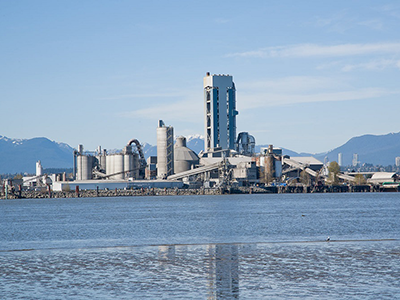
Government of Canada supports emerging clean technologies from cement to steel
Mike Edwards
News Government of Canada Lafarge UBC Lafarge Canada Inc.'s cement plant in Richmond, BC.
Lafarge Canada Inc.'s cement plant in Richmond, BC. The Government of Canada has announced a combined investment of close to $14 million to eight organizations that are advancing emerging clean technologies to meet its environmental targets. Funding comes from Clean Growth Program, a $155-million investment in clean technology research, development, and demonstration projects in three Canadian sectors: energy, mining, and forestry, as well as Natural Resources Canada’s Energy Innovation Program.
These projects include:
- $4,583,000 to Canfor Pulp Limited in Prince George, BC, to execute a front-end engineering design study to support a biomass to low-carbon biofuel plant, which will produce advanced biofuels that can be used as a liquid transportation fuel;
- $2,000,000 to Saltworks Technologies Inc. in Vancouver to accelerate the commercialization of a desalination technology to treat water from conventional oil production;
- $1.9 million to accelerate the development of innovative technologies that will reduce fossil fuel consumption at Lafarge Canada Inc.’s cement plants in Richmond, BC, and Brookfield, NS;
- $1,852,941 to ArcelorMittal Dofasco in Hamilton, ON, to demonstrate the ability to use biocarbon in an industrial blast furnace in support of future commercial technology demonstration at the ArcelorMittal Dofasco plant;
- $1,601,950 to the University of Toronto in Toronto to develop an electrocatalytic-based carbon dioxide (CO2) conversion technology, which can convert captured CO2 into low-carbon-intensity synthetic methane (CH4) using clean electricity and water;
- $1,160,587 to the University of British Columbia in Vancouver to create breakthrough advances in thermochemical processes to economically produce renewable natural gas from forest residues;
- $700,000 to Applied Quantum Materials Inc. in Edmonton to convert ordinary glass windows into scalable luminescent solar concentrators for the generation of electrical power; and
- $453,993 to GHGSat Inc. in Montney, BC, to demonstrate that GHGSat’s satellite-aircraft hybrid system provides equivalent annual methane leak mitigation compared with optical gas imaging (OGI) surveys, while detecting major leaks at least three times more quickly, all at a 25 percent lower cost to operators.
Federal funding was provided to Lafarge Canada and GHGSat through Natural Resources Canada’s Energy Innovation Program, which supports clean energy innovation. The other projects in this list received funding under the Clean Growth Program.
Print this page